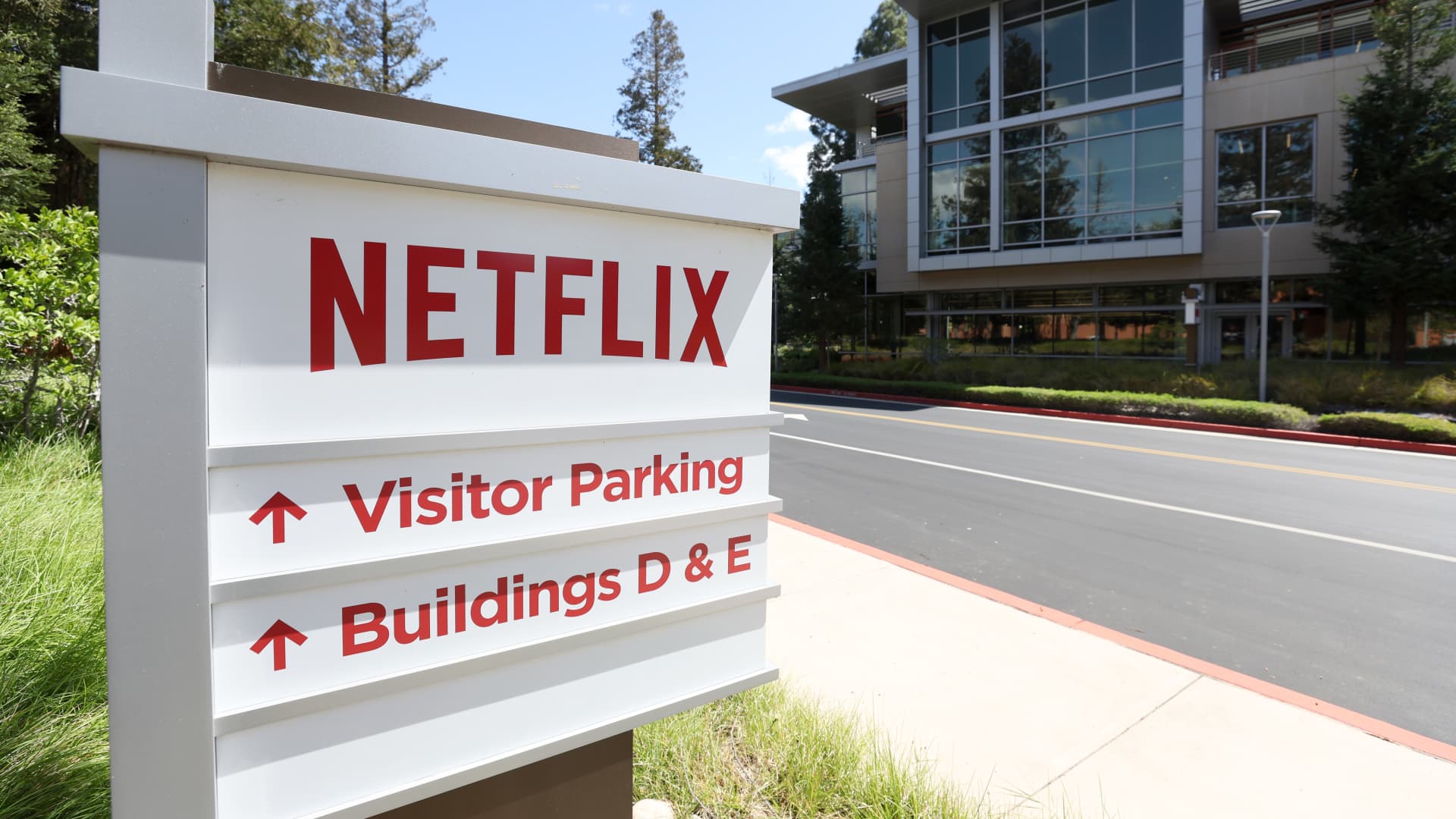
A sign is posted in front of Netflix headquarters on April 20, 2022 in Los Gatos, California.
Justin Sullivan | Getty Images
A day after Netflix reported that its second-quarter slide in subscribers was much smaller than investors had feared, a different takeaway may sink in from the earnings report at the world’s largest streaming service: A years-long debate about whether Netflix is spending too much on content seems to be over now.
The key is that Netflix eked out a positive number for operating cash flow in the quarter, despite spending $1.3 billion more on content than it did in the first three months of this year, as it launched a new series of its “Stranger Things” franchise and wrapped up its $200 million “The Gray Man” action thriller. For the first half of the year, Netflix said it made $1 billion in cash flow – a number analysts say will double, and may triple, by 2023.
“Netflix’s revenue will grow 10% to 15% next year, but the content spend will grow zero,” said Robert Cantwell, manager of the Compound Kings Exchange Traded Fund in Nashville, which has 3.9% of its fund in Netflix stock as of July 19. “You’ll see $3 billion to $3.5 billion next year in free cash flow.”
Critics have long zeroed in on the fact that Netflix’s spending on new movies and TV shows has been more than its reported profits because of accounting rules that let the content investment be reported as expenses over several years. But that ended in the first quarter of this year, and was sustained in the second even with the extra spending.
Netflix said on its quarterly earnings presentation that it will keep content spending level at about $17 billion annually for the next couple of years. Two executives said spending would stay “in that zip code.” That’s up from $11.8 billion in 2020, and little changed from $17.7 billion last year.
The company spent most of earnings call talking about its plans to add an advertising supported tier to its service offerings, letting Netflix cash in on households that don’t want to pay $10 to $20 a month for a subscription. Many of those households are using passwords belonging to friends or family, skirting Netflix’s rules.
The combination of leveling off content spending and adding ad revenue is where the cash flow increase will come from, according to Cantwell and Evercore ISI analyst Mark Mahaney.
Mahaney says Netflix the company should reach $2.5 billion in 2023 cash flow and could reach $4 billion by 2024.
“If you generate $4 billion in cash flow, that’s [more than] a 4% yield,” said Mahaney, a longtime Netflix bull who now rates the shares as a market performer. “That’s solid. On 2023, it’s trading at 45 times free cash flow. That’s not so interesting.”
Neither analyst doubts that Netflix’s ad strategy will work. Competitors like Hulu get about 15% to 20% of revenue from advertising now, Cantwell said, and Mahaney says Netflix should have made this move a couple of years ago.
At Netflix, 20% of sales would be as much as $6 billion a year, for a company whose market cap is about $91 billion now. That revenue would carry gross margin higher than the 40% profit the company’s content business generates now, with less capital investment, Cantwell said.
Because it will take time to build up the ad business, it should contribute $250 million to $300 million to cash flow next year, Cantwell said.
The problem is, the extra cash flow still doesn’t change the fact that Netflix is making a transition from being one of the century’s best growth stocks – its 2002 IPO price, adjusted for stock splits, works out to $1.07 a share, and it went as low as 65 cents later that year – to being a play for value investors who look for fatter earnings and pay lower price-to-earnings multiples to get them.
At the peak, Netflix bulls talked about the company attracting as many as 800 million global subscribers, Cantwell said, up from 221 million now. That ship has likely sailed, he said, as many international markets have proven tougher to crack than some assumed. Netflix has already captured 73 million subscribers in the U.S, and Canada, more than half of the households in the two nations combined.
The cash flow won’t be big enough to really galvanize value investors until 2024 or later, Mahaney said.
“It’s a transition,” he said. “Growth is becoming much more moderate and cash flow is getting much more interesting.”
But growth has been Netflix’s calling card for years, and a reliable magnet to attract content creators, customers and investors alike. With growth slowing, the pace of new content addition leveling off, and its competitive advantages over rivals in technology having closed, the risk is that it will need to relax its newfound spending discipline to stay ahead of rivals like Warner Bros. Discovery‘s HBO Max and Disney Plus, Cantwell said.
“The challenge is that it assumes Netflix can make content that has long-term library value, and that is one of the hardest bets to make about Netflix at this point,” he said. “You’re betting on them to make better content than they have.”
from Stock Market News – My Blog https://ift.tt/0HrsvtN
via IFTTT

No comments:
Post a Comment